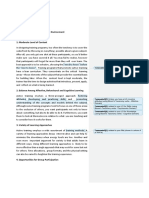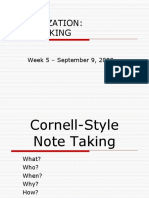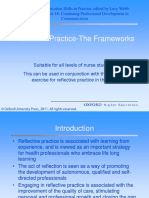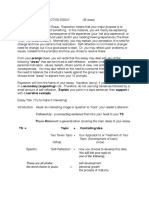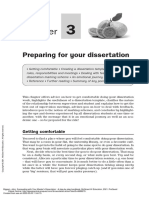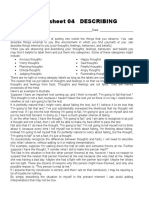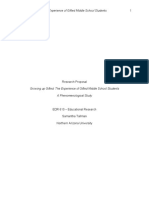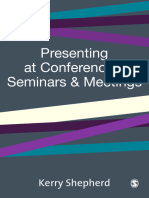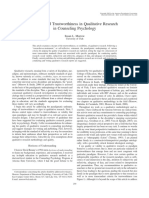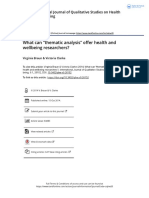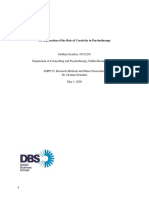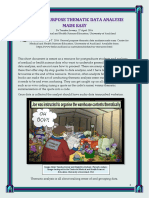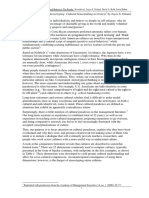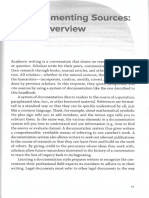0 ratings0% found this document useful (0 votes) 179 views7 pagesHarris-Using Sources Effectively
Copyright
© © All Rights Reserved
We take content rights seriously. If you suspect this is your content,
claim it here.
Available Formats
Download as PDF or read online on Scribd
Using Sources
Effectively
Strengthening Your Writing
and Avoiding Plagiarism
Fifth Edition
Robert A. Harris�Meaning
because ‘ng a reason or evidence to support a
for the reason that ‘proposition
‘on account of
therefore fesenting a conclusion that follows from the
it follows that discussion
asa result
however at the same time contrast to or conflict with the
nevertheless
still
(on the other hand
though this may be
3.4 Take Careful Notes
“A major source of confusion, inaccuracy — and sometimes plagiarism — lies in careless or
improper note-taking practices. Students who include quotations, summaries, paraphrases,
and their own analyses in their reading notes, without clearly distinguishing among those
different kinds of information, create difficulties for themselves. If you haven't already had
the experience, you will be surprised how confusing notes can be once you leave them for
a day or two and come back to work with them—unless you practice careful note-taking
behavior. Following are some suggestions that will enable you to take careful notes.
Use a Labeling System
‘Make use of a system for labeling the various kinds of notes you type up: quotations,
comments by you, paraphrases, or summaries. Then when you are making notes as you
read a book or an article, apply the teclinique as you read. The goal is to distinguish
clearly what each note represents. These distinctions will also enable you to work more
quickly because the meaning of each note will always be clear.
¢ Include the full bibliographic citation at the beginning of your notes so that
subsequent references can be by author and page number or some other short-
ened format. See Examples 3.4.1 and 3.4.2 below.
¢ Label quotations with the symbol “++Q++” or other distinguishing mark.
‘And, of course, use quotation marks around every quotation, and include a
citation, For the sake of clear note taking, put in the quotation marks even for
Jong quotations that might later become block quotations in your paper (with-
out quotation marks). I's always easier to remove a pair of quotation marks
than it is to wonder whether a passage is a quotation or your own work.
¢ Label paraphrases with the symbol “++P++” or other distinguishing mark.
When you tum the text of a source into your own words in a paraphrase, you�‘Gaaeren 3 # Preranine Your Sounces ——
may at a later time confuse it with your own ideas unless it is clearly labeled.
Include a citation. A symbol from those available in your word processor can
be used for marking paraphrases in document files. For example, if you use
Word, you'll find © in Webdings.
@ Label summaries with the symbol ’++S++” or other distinguishing mark.
‘Summaries reduce the material to a shorter form in your own words, so they
are even more likely than paraphrases to be confused with your own work
unless they are clearly labeled. Once again, remember to include a citation.
¢ Label your own ideas with the symbol “++Mine++” or other mark or sym-
bol. When you add commentary, analysis, or simply write down an idea that
occurred to you as you read, circle that writing and attach a label. Your ideas
are valuable. Protect them. A symbol such as a happy face © (in Wingdings in
Word) should always remind you that both the words and the ideas are yours.
¢ The labeling system you use can be your own, and it can use any letters or
symbols (or colors or fonts) you want, as long as you are consistent and the
system is meaningful to you.
Example 34.1
Sample Notes
(Quoted text with bibliographic citation: book, APA style:
Doe, J. (2012). Tracking subatomic particles. New York: Physics Press.
+4Q++ "The question remains: Are quarks the fundamental building blocks of matter, or
is there something smaller?” middle of page 261
++Q++ “There are perhaps 100 quintillion atoms in a grain of sand, and yet matter is
‘mostly space.” very bottom of page 144
‘Quoted text with bibliographic citation: book, MLA style:
Doe, John. Tracking Subatomic Particles. Physics Press, 2012.
4+4Q#+ “The question remains: Are quarks the fundamental building blocks of matter, or
is there something smaller?” middle of page 261
+Q#+ “There are perhaps 100 quintillion atoms in a grain of sand, and yet matter is
‘mostly space.” very bottom of page 144
Example 3.4.2
Sample Notes
‘Quoted text with bibliographic citation: article, APA style:
Doe, J. (2015). "A new test for blood evidence.” Journal of Forensic Science, 22, 265-274
+40%+ "The use of luminol can be problematic because it can produce false positives for
blood and damage real blood.” three lines from bottom of page 266
Quoted text with bibliographic citation: article, MLA style:
Do, Jane. “A New Test for Blood Evidence.” journal of Forensic Science, vol. 2, 2015, pp. 265-274.
440+ “The use of luminol can be problematic because it can produce false positives for
blood and damage real blood.” three lines from bottom of page 266
Comment: Note that the bibliographic citation for the article includes the beginning and
ending page numbers of the article.
‘Another way to distinguish among quotations, paraphrases, summaries, and your
vn thinking is to use different fonts, text colors, or highlighting. If you plan to print your
45�‘cnapren 3 # Prepnane Your Sounces
paper at any point, remember that text colors and highlighting will not print on black and
white printers.
Remember: Not only do you want to be careful to identify and give credit to your
sources when you use them, but you also want to be sure that you do not accidentally give your
source credit for your own thinking. Your ideas are important.
Quote Exactly
If you are working with physical documents, where you must transcribe the words by
handwriting, typing, or even scanning using optical character recognition software, there
isa chance for errors to enter the text. Even copying and pasting from an electronic source
can introduce errors, especially at the beginning and end of the quotation, because words
or punctuation marks are sometimes cut off. Double-check to assure that the text has been.
copied accurately —that all the words, including proper names, are spelled correctly and
that no words have been left out. The word not is commonly left out when copying manu-
ally, and the loss of that word obviously has a critical effect on the meaning of a quotation.
‘Quoting exactly also means that you are not permitted to change the spelling of any
words in the source, even if that spelling is archaic, incorrect, or nonstandard. For exam-
ple, you may encounter British spellings such as luumour, honour, or aluminium. In such a
case, follow the text. If there is an error in your source text, where a word has been left out,
do not silently correct the text. You may insert a missing word with brackets [like this]. In
the situation where you encounter a typographical error, you must still quote the source
exactly, and then indicate that you are indeed transcribing verbatim by adding the word
sic in brackets. See Chapter 4, Section 4.4 for additional information.
Keep a Quotation File
One of the most common reasons given for inadvertent plagiarism is “confusion in my
notes.” In other words, because of poor note-taking control, the writer mixed up quoted
material with the writer’s own words and, when it was time to draft the paper, the writer
‘was unable to see the difference, resulting in plagiarizing the quoted material.
"A good way to help protect yourself from this problem is to keep a separate file for
quotations that you copy from electronic sources such as the Web. When you use the
quoted material, copy it from your file and paste it into your paper (with appropriate
citation, of course). By doing that, if there is ever any question about the quotation (or
paraphrase or summary), you can look back at the original and compare.
‘A separate file for each source makes organizing quotations easy, and it allows you to
enter the full bibliographic citation only once at the top of the file, and then use a short ref
erence in subsequent notes. (Gee the difference between Example 3.4.2 with a full citation
and Example 3.5.1 with a brief reference.)
Keep Copies of Each Source
Your Notes
Keep your reading notes in the same file as your copy of the source. That way,
the source is handy for further reference and for last minute triple-checking of the
46�a cnrrer 3 4 Prerarina Your Sources
use of the source, whether by quotation, summary, or paraphrase. The saved source
includes the context of the words around your quotation or other reference, so that
you can recheck that your interpretation is based on an accurate understanding. Fur-
ther research and thinking may also lead you to use more of the source than you orig-
inally planned.
As you work with your sources and notes, do not delete anything. Keep copies of
earlier versions of your paper. If any confusion should arise—over what is a quotation
and what is your own thinking, for example— you will have the earlier version available
to you for consultation and clarification. Early versions of notes may also be useful if you
decide to change direction in the paper. And, of course, a set of intermediate drafts will
help protect you from a false charge of plagiarism (see Section 3.6).
3.5 Positioning Your Sources
‘A major feature of the research paper is to synthesize all of the ideas, facts, and opin-
ions presented by your sources and combine them into an organized discussion. Every
source needs to be blended into the overall structure in a seamless whole. Synthesize,
by the way, comes from the root thesis, meaning “to pull,” and the prefix syn, meaning
“together.” Literally, then, your task is to pull together the various sources into a coherent,
logical discussion. For an outstanding paper, it should appear that it’s not just you doing
the pulling but your sources are pulling together along with you.
Sound difficult? Itis. However, if you do the work described in this section —and do it
carefully—your research paper will practically arrange and write itself.
‘Add Purpose Comments or Indicators to Your Notes
Whether you put individual notes on note cards or in word processing files, a
good strategy is to indicate the category grouping or orientation of each note. That is,
describe briefly how the note (quotation, summary, paraphrase, your own comment)
might fit into your structure. Does the note provide background or contextual informa-
tion, support a theory, rebut a claim, provide statistics for or against a conclusion, or
belong to a particular theoretical or interpretive camp? When you later assemble your
sources for use, these grouping labels and comments will enable you to arrange them
more easily.
‘As your research progresses, you will begin to get a feel for how your sources might
be arranged. When you are far enough along, you can begin to add organizational com-
ments to your notes. See the bracketed comment in the example below, where the student
has tentatively suggested the connection between two sources.
Example 3.5.1
Sample Note
Johnson, “ Asynchronous,” 343-45 >>>PRO asynchronous
+45+ and ++Q#+ Johnson believes that asynchronous interactions can be more beneficial
to the student than real-time (live or distant) ones, because “many otherwise shy learners
are emboldened by the protected arena of offline communication.” 345 [Putafter Jackson's
criticism? Jackson, “Learning Modes,” 298]
47�_— caneren 3 # Prepanine Your Sounces
+#Minet+ Johnson focuses on student willingness to ask the professor questions in e-mail,
‘but doesn’t cover threaded discussion groups. A weakness to his argument?
Comment
Inthis Sample Note, the researcher identifies the source briefly (“Johnson, Asynchronous”)
‘The student keeps a running bibliography, so the full citation is not needed for each note.
‘The page numbers indicate the range of the article or book being referred to in the note
(here, partially summarized and partially quoted, as the symbols indicate). The marker
“>>>PRO asynchronous” is a category grouping, telling the researcher that this note con-
tains information that favors asynchronous learning. The bracketed comment at the end
is an early thought by the researcher about how the source might eventually fit into the
paper. And the researcher's own analysis or commentary is identified by ++Minet+, so
that itis clearly distinguishable from the source.
Arrange Your Sources by Their Relationship to Each Other
‘The sources you incorporate into your paper must blend together in a coherent and
effective way. To help you with the blending process, identify the logical relationships
among the sources. How can they be synthesized? Table 3.2 contains a sampling of possi-
ble ways one source can exist in relation to another or respond to another.
Taste 3.2 Examtes oF Source RELATIONSHIPS
agrees disagrees ‘comments on
supports, contradicts offers an alternative
extends rebuts (gives counterargument) updates
provides supporting data __refutes (proves wrong) offers a nuance
gives examples supporting gives a counterexample offers an analogy
concurs crit clarifies
acknowledges ‘opposes reviews:
applies successfully differs evaluates
provides additional reasons conflicts, assesses
adds more evidence diverges interprets
replicates a study doubts qualifies
finds common ground ‘questions, harmonizes
Often, however, the relationship among sources will be more like a matrix than a one-
to-one connection. In such cases, you might have a set of relationships like these:
‘@ Source A and Source B both support Source C, who is qualified by Source D
‘and whose idea is extended by Source E, leading you to infer idea X, which
becomes support for your central idea.
¢ Source F presents a powerful but vague statement that Source G defines and
Sources H and I provide clear examples for.
48�Cuaeren 3 Prepanino Your Sources
# Source J presents a finding or interpretation that Source K criticizes strongly.
Source L finds some common ground, which Source M elaborates. Meanwhile,
Source N argues that J and K are both wrong and proposes another way. You
draw a conclusion by sorting out the claims of all these sources.
Create an Outline of Possible Source Uses
To make writing your paper much easier and to ensure that your sources enter
the paper at the right time, make a list or construct a diagram representing a plan for
all your sources working together. Each entry in the plan should reflect the role you
want each source to play in your presenta-
—__ ‘tion and when it should be incorporated. If
you like military analogies, your objective
asus 3.3 Samp Ourune oF Source Use ig to persuade your reader that your the-
sis is believable, your strategy is to follow
aoe Bike OF Eee the overall plan you have created, and your
smith, 344 larly the protiem tactics involve presenting your sources in
Jones, 16 and 22 order and by role. Table 3.3 provides an
example of a simple list.
Doe, 447 Previously proposed Relying on a plan like this will help you to
Alberts, 248 solutions
visualize the overall movement of your paper,
Whitston, 2739-42 which will allow you to see at a glance how
Maercus, 344-56 Summarizes well organized and how strong your argu-
‘Swanson, 16-47 (if inadequacy of ‘ments likely to be. More than that, you'll get
needed) previous solutions _a good idea of how your sources will be sup-
porting you as you argue for your central idea
and how you will be synthesizing the overall
discussion. A plan like this won't make the
Jones again, 27-28 Supports my solution
ee Provides reasons ™Y per write itself, of course, but it will make
Grafting much easier.
ve Note that you are not chained to the first
version you write down of such a plan. Like
Panda i2t——Grskausteer Sp ine, sepesens ment Posty
thinking only, not the last word. Writing is
ee _ arn organic, iterative process. Many writers
— get new ideas during the process of writing,
realizing that they need to discuss some new
aspect of the topic; they also recognize that a planned idea needs to be moved earlier or
Tater; and, often with some feeling of disappointment, they realize that a planned discus-
sion that they were particularly fond of really doesn’t fit into the paper at all.
‘Moreover, many writers write from the inside out in a nonlinear way. Tt’ like start-
ing with a lump of dough (your central idea or thesis) and then pushing it out in various
directions at various times. Sure, you end up with a product that seems to have been writ
ten from beginning to end, but that's the art, not the actual process. So, as a hint to those
students who suffer from writer’s block, have a plan but write first whatever part of the
paper you feel like. Start in the middle if you want to.
49

